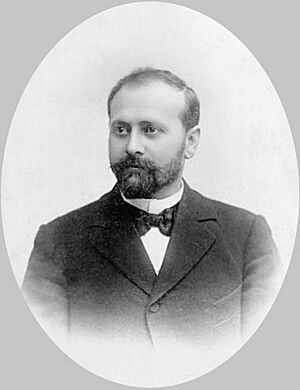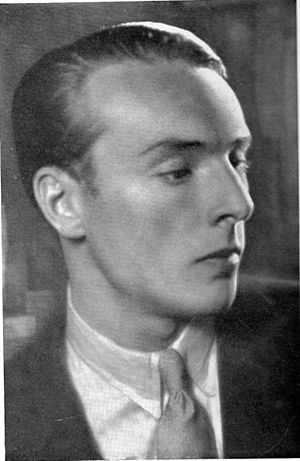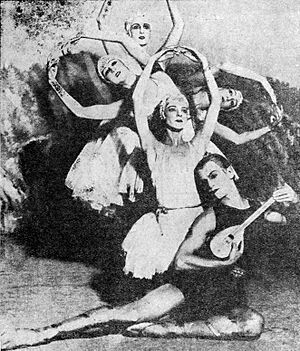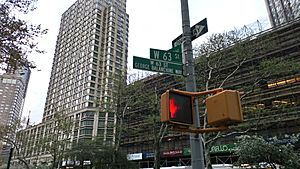George Balanchine facts for kids
Quick facts for kids
George Balanchine
|
|
|---|---|
| გიორგი მელიტონის ძე ბალანჩივაძე | |
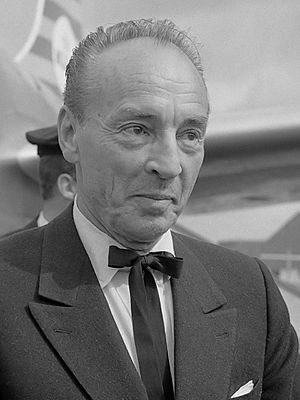
Balanchine in 1965
|
|
| Born |
Georgiy Melitonovich Balanchivadze
January 22, 1904 Saint Petersburg, Russian Empire
|
| Died | April 30, 1983 (aged 79) New York City, U.S.
|
| Occupation | Dancer, choreographer, director |
| Years active | 1929–1983 |
| Spouse(s) |
|
| Partner(s) | Alexandra Danilova (1926–1933) |
| Awards | Presidential Medal of Freedom, among others (see below) |
George Balanchine (born Georgiy Melitonovich Balanchivadze; January 22, 1904 – April 30, 1983) was a famous Georgian-American ballet choreographer. He is known as one of the most important choreographers of the 20th century. Many people call him the "father of American ballet."
Balanchine helped start the New York City Ballet. He was its artistic director for over 35 years. His ballets often told stories without words. They used simple costumes and sets, and were performed to classical music.
He was born in Saint Petersburg, Russia. Balanchine combined the ballet techniques he learned at the Imperial Ballet School with other dance styles. He learned these styles while working on Broadway and in Hollywood. This mix created his special "neoclassical style."
Balanchine was famous for how well he used music in his dances. He showed music through movement. He worked a lot with famous composers like Igor Stravinsky. In 1933, a young arts supporter named Lincoln Kirstein invited Balanchine to America. Together, they started the School of American Ballet. They also co-founded the New York City Ballet.
Contents
Early Life and Family
George Balanchine was born Georgiy Melitonovich Balanchivadze in Saint Petersburg, Russia. His father, Meliton Balanchivadze, was a Georgian opera singer and composer. Meliton helped start the Tbilisi Opera and Ballet Theatre. He later became the culture minister for the short-lived Democratic Republic of Georgia.
Many of Balanchine's Georgian relatives were artists or soldiers. Not much is known about his Russian mother's side of the family. His mother, Maria Nikolayevna Vasilyeva, was Meliton's second wife. She loved ballet and could play the piano well. She also worked at a bank. Even though she loved ballet, she wanted George to join the military.
George had three other brothers and sisters. His brother, Andrei Balanchivadze, became a well-known Georgian composer, just like their father.
Starting His Dance Career
Early Training and Auditions
When he was a child, George Balanchine wasn't very interested in ballet. But his mother wanted him and his sister Tamara to try out. George's brother, Andria, chose music like their father. Tamara's dance career ended sadly when she died trying to escape from Leningrad during a war.
In 1913, at age nine, Balanchine moved to Saint Petersburg. He was accepted into the Imperial Ballet School. This was the main school for the Mariinsky Ballet. He learned from teachers like Pavel Gerdt.
Balanchine stayed at the Mariinsky Theater during World War I. The theater closed in 1917 because of a government rule. It reopened in 1918. After graduating in 1921, Balanchine studied at the Saint Petersburg Conservatory. He also danced in the corps de ballet (the group of dancers) at the State Academic Theater. He studied piano, music theory, and composition.
In 1920, while still a teenager, Balanchine created his first dance. It was a duet called La Nuit. The school directors didn't like it because it was experimental. He and his friends performed it anyway. He then created another duet, Enigma, where dancers performed without ballet shoes. While teaching, he met Tamara Geva, who later became his wife. In 1923, Balanchine formed a small dance group called the Young Ballet.
Joining Ballets Russes
In 1924, the Young Ballet got permission to leave Russia and tour Europe. Balanchine, his wife Tamara Geva, and other dancers went to Germany. Their shows in Berlin were not very popular. They had to perform in small towns and even in beer gardens. They struggled to pay for hotels and food.
In London, their performances were also not successful. With their visas running out, they moved to Paris. There, a famous show organizer named Sergei Diaghilev invited Balanchine to join his company, the Ballets Russes.
Balanchine was only 21 years old. He became the main choreographer for this very famous ballet company. Diaghilev told him to change his name from Balanchivadze to Balanchine. Diaghilev soon made Balanchine the ballet master (the person in charge of teaching and creating dances).
Between 1924 and Diaghilev's death in 1929, Balanchine created ten ballets. He worked with famous composers like Igor Stravinsky and Sergei Prokofiev. He also worked with artists like Pablo Picasso who designed sets and costumes. They created new works that combined all these art forms.
One of his most important new works was Apollon musagète (Apollo and the Muses) in 1928. He created it with Stravinsky. This ballet was very new and fresh. It mixed classical ballet with Greek myths and jazz movements. Balanchine called it "the turning point in my life." Apollo is seen as the first neoclassical ballet. It also made the male dancer a very important part of the show. The ballet used simple costumes and sets so the audience could focus on the dance. Balanchine believed music was the most important part of creating a dance.
Balanchine hurt his knee badly, which meant he had to stop dancing himself. This ended his career as a performer.
After Diaghilev died, the Ballets Russes company went out of business. To make money, Balanchine started creating dances for shows in London. He also worked as a guest ballet master for the Royal Danish Ballet in Copenhagen.
In 1931, a new company called the Ballets Russes de Monte-Carlo was formed. Balanchine was hired as a choreographer. But in 1933, he was let go. Balanchine then started his own company, Les Ballets 1933, which performed for only a few months.
Moving to the United States
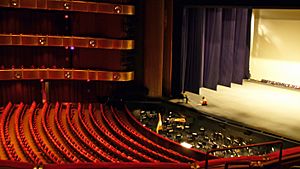
When Balanchine came to the United States in 1933, he insisted on starting a ballet school first. He wanted to train dancers with strong technique and his special style. With help from Lincoln Kirstein, the School of American Ballet opened on January 2, 1934.
Later that year, Balanchine's students performed his new work, Serenade, set to music by Tchaikovsky. The School of American Ballet became a training ground for dancers of the New York City Ballet and other companies around the world.
During the 1930s and 1940s, Balanchine also choreographed dances for Broadway musicals. These included shows by famous composers like Richard Rodgers. In 1936, for the musical On Your Toes, Balanchine was specifically credited for "Choreography." This was the first time a dance creator received this special credit for a Broadway musical. His dances in musicals were unique because they helped tell the story.
Time in Hollywood
In 1938, Balanchine moved his company to Hollywood. He created dances for five movies, all starring Vera Zorina, who became his second wife. He renamed his company the American Ballet Caravan and toured with it. From 1944 to 1946, Balanchine worked as a choreographer for the Ballet Russe de Monte-Carlo.
Returning to New York
Soon, Balanchine started a new dance company called Ballet Society, again with help from Lincoln Kirstein. He kept working with modern composers. In 1946, he created The Four Temperaments, a modern and abstract ballet.
After some successful shows, especially with the ballet Orpheus (created with Stravinsky), the City of New York offered the company a home at the New York City Center. This was a big step!
In 1954, Balanchine created his famous version of The Nutcracker. He even played the role of Drosselmeyer in it. The company still performs this ballet every year during the Christmas season in New York City. Other famous ballets he created for New York companies include Firebird, Allegro Brilliante, Agon, and Jewels.
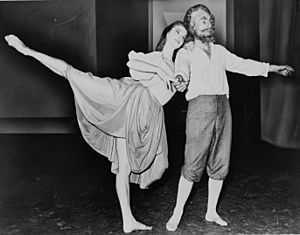
His 1967 ballet Jewels shows many of Balanchine's special dance qualities. The dancers perform very fast and precise movements. The choreography is hard, and every dancer must do their part perfectly. His use of music is also very clear in this work. Many of his famous works are still performed today by the New York City Ballet at the Lincoln Center.
Later Life and Death
In his final years, Balanchine had heart problems and had surgery.
George Balanchine died on April 30, 1983, at age 79, in Manhattan. He had a rare brain disease called Creutzfeldt–Jakob disease, which was only found after he passed away. He started showing symptoms in 1978, like losing his balance. As the disease got worse, his balance, eyesight, and hearing got worse too. By 1982, he was very ill. The night he died, his company still performed as scheduled at Lincoln Center.
Many people praised Balanchine's huge impact on ballet. He created 465 works in his lifetime. He expanded the traditions of classical ballet. His choreography is still used today, and the School of American Ballet still teaches his methods. He is one of the most famous choreographers of the 20th century.
He had a Russian Orthodox funeral. He was buried at the Oakland Cemetery in Sag Harbor, New York.
Personal Life
In 1923, Balanchine married Tamara Geva, a dancer who was sixteen. After they separated, he was with ballerina Alexandra Danilova from about 1924 to 1931. They lived together, but never officially married.
He married and divorced three more times. All of his wives were dancers in his companies: Vera Zorina (1938–1946), Maria Tallchief (1946–1952), and Tanaquil LeClercq (1952–1969). He did not have any children.
Legacy and Honors
With his School of American Ballet, New York City Ballet, and hundreds of choreographed works, Balanchine changed American dance. He created neoclassical ballet, a unique style known for its speed and energy.
A monument was built in Balanchine's memory at the Tbilisi Opera and Ballet Theatre in Georgia. A crater on Mercury was also named after him.
A part of West 63rd Street in New York City was renamed George Balanchine Way in June 1990.
Awards
- 1975 French Légion d'honneur
- 1978 Kennedy Center Honors
- 1980 Austrian Decoration for Science and Art
- 1983 Presidential Medal of Freedom
- 1987 National Museum of Dance's Mr. & Mrs. Cornelius Vanderbilt Whitney Hall of Fame (after his death)
- 1988 Inducted into the American Theater Hall of Fame
Selected Choreographed Works
- 1928 Apollo
- 1929 The Prodigal Son
- 1935 Serenade
- 1936 Slaughter on Tenth Avenue
- 1936 Zenobia
- 1937 Jeu de cartes
- 1941 Concerto Barocco
- 1941 Tschaikovsky Piano Concerto No. 2
- 1942 Circus Polka
- 1946 La Sonnambula
- 1946 The Four Temperaments
- 1947 Symphonie Concertante
- 1947 Symphony in C
- 1947 Theme and Variations
- 1948 Orpheus
- 1949 Bourrée fantasque
- 1949 The Firebird
- 1951 La Valse
- 1951 Swan Lake (Act 2)
- 1952 Bayou
- 1952 Scotch Symphony
- 1954 Ivesiana
- 1954 Western Symphony
- 1956 Allegro Brillante
- 1956 Divertimento No. 15
- 1957 Agon
- 1957 Square Dance
- 1958 Gounod Symphony
- 1958 Stars and Stripes
- 1959 Episodes
- 1960 Donizetti Variations
- 1960 Liebeslieder Walzer
- 1960 Monumentum pro Gesualdo
- 1960 Ragtime (I)
- 1960 Tschaikovsky Pas de Deux
- 1961 Raymonda Variations
- 1962 A Midsummer Night's Dream
- 1963 Bugaku
- 1964 Tarantella
- 1965 Don Quixote
- 1965 Harlequinade
- 1966 Brahms–Schoenberg Quartet
- 1966 Variations
- 1967 Divertimento Brillante
- 1967 Jewels
- Emeralds
- Rubies
- Diamonds
- 1967 Ragtime (II)
- 1968 Metastaseis and Pithoprakta
- 1968 Requiem Canticles
- 1968 La Source
- 1968 Slaughter on Tenth Avenue
- 1970 Tschaikovsky Suite No. 3
- 1970 Who Cares?
- 1972 Duo Concertant
- 1972 Pulcinella
- 1972 Scherzo à la Russe
- 1972 Stravinsky Violin Concerto
- 1972 Symphony in Three Movements
- 1973 Cortège Hongrois
- 1975 Le tombeau de Couperin
- 1975 The Steadfast Tin Soldier
- 1976 Chaconne
- 1976 Union Jack
- 1977 Vienna Waltzes
- 1978 Ballo della Regina
- 1978 Kammermusik No. 2
- 1979 Le Bourgeois Gentilhomme
- 1980 Robert Schumann's Davidsbündlertänze
- 1980 Walpurgisnacht Ballet
- 1981 Garland Dance
- 1981 Mozartiana
- 1982 Élégie
- 1982 Noah and the Flood
Notable Students
Balanchine taught many students over the years, sharing his artistic ideas. Some of them include:
See also
 In Spanish: George Balanchine para niños
In Spanish: George Balanchine para niños
- Balanchine method
- Contemporary ballet
- List of dancers
- List of Russian ballet dancers
- List of Eastern Bloc defectors
- Category: Ballets by George Balanchine


